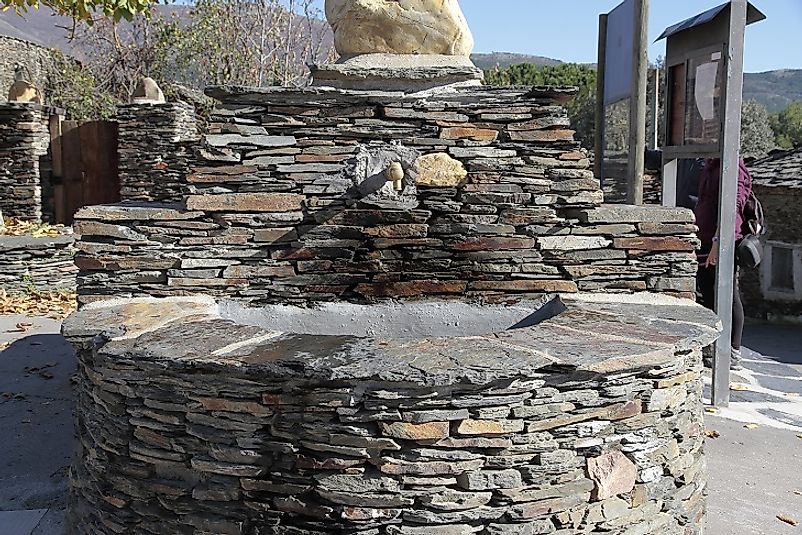Top Slate Exporting Countries

Slate is the finest grained type of foliated metamorphic rock. It is mainly composed quartz with either illite and muscovite. Slate is also often composed of pyrite, chlorite, biotite, and hematite, and is less frequently composed of various other minerals, such as graphite or feldspar. It is found in a variety of colors, thought the most common are black, grey and blue-grey. It is usually formed by a metamorphosis of mudstone and shale, or the less common combination of mudstone and basalt, under relatively low temperature and pressure conditions. Now that some of the basics of shale have been discussed, lets see the process behind producing and exporting it.
The Processes Involved in Exporting Slate
Extraction
The first step in extracting shale is identifying a geological area as a possible shale deposit. Once an area has been identified and the extractor as gone through the process of obtaining the rights to dig in the area then mining can begin. The next step is removing the layers of dirt, rock and vegetation with heavy machinery and equipment that is the shale deposit. All of this extra material that is removed is sent to a storage area, in case it needs to be used for later reclamation of the site. After this the slabs of shale are removed from the site with either a small explosive charge, by cutting through it with a diamond saw belt or by driving steel wedges through the cracks in the shale to pry it out. Any loose pieces of shale are picked up by heavy machinery, such as a front end loader. The machinery then transports the shale to be inspected for grading and if it passes the shale is then shipped out to the processing area.
Processing
Once the shale arrives the first step in processing it is the primary cutting and shaping of the shale. The cutting process is done with either a circular saw blade, diamond wire saw or a steel shot blade. The next step is called splitting in which machinery or people with chisels and hammers manually finish shaping the process. Depending on the product the shale is being made into, such as that used for roofing, this may be the last step in the process. The next step is the finishing process in which the shale is given the finished look it needs depending on its intended purpose. This step can be done in a variety of ways, including polishing, thermal flame treatment, sandblasting, water blasting and being machine gauged. The next option step is called secondary cutting, which is only necessary if the final product the shale is being made into feature custom shapes, sizes or features. This step is most often done using power drills, trimmers and punchers. The final step is packaging the finished slate product and then it is ready to be transported out to retailers.
Shipping
For most of the recent history of slate mining, slate was transported by rail from mine to factory and then from factory to mine. In recent decades with the rise of roads, cars and highways and the decline of rail, trucks are now the most common way to transport shale on land. If shale has to be transported over longer distances or the sea, it is transported via ocean freighter or airplane.
Uses for Slate
When most people think of what slate is used for they probably think of slate being used for roofing tiles/shingles. Shale is great for roofs since it can be cut so thin and can stand up so well to moisture and freezing. Slate titles are also used in interior flooring, exterior flooring, stairs, walkways, wall cladding and as decorative additives. It is also used in laboratory bench tops, billiard table tops and counter tops. Historically shale used to be used in electric switchboards, relay controls, blackboards and writing utensils.
Top Importers of Slate
According to the Observatory of Economic Complexity (OEC) the world's largest importer of slate is the United Kingdom, who imports 13% of the world's slate. Rounding out the top five are France (11%), Italy (8.8%), Germany (7.9%) and the United Arab Emirates (5.9%). In other regions of the world, the leading importers are the United States (3.6%) in North America, Australia (2.5%) for Oceania, Colombia (0.80%) in South America, and South Africa (0.74%) for Africa.
Top Slate Exporting Countries
| Rank | Country | 2015 Slate Exports (USD) |
|---|---|---|
| 1 | India | $18,222,000 |
| 2 | China | $16,083,000 |
| 3 | France | $11,311,000 |
| 4 | Spain | $9,983,000 |
| 5 | Portugal | $4,069,000 |
| 6 | United Kingdom | $2,935,000 |
| 7 | Greece | $1,505,000 |
| 8 | Italy | $1,487,000 |
| 9 | Belgium | $1,433,000 |
| 10 | Germany | $1,388,000 |







